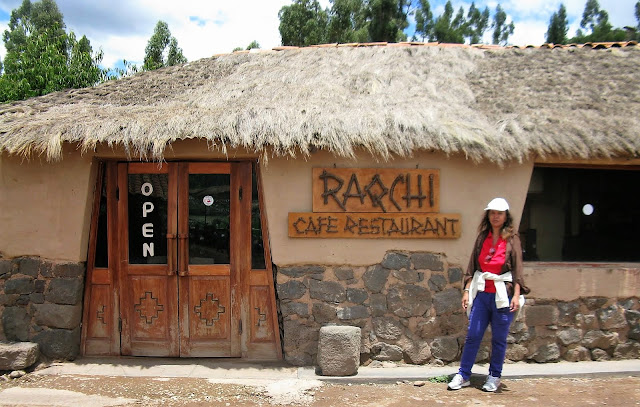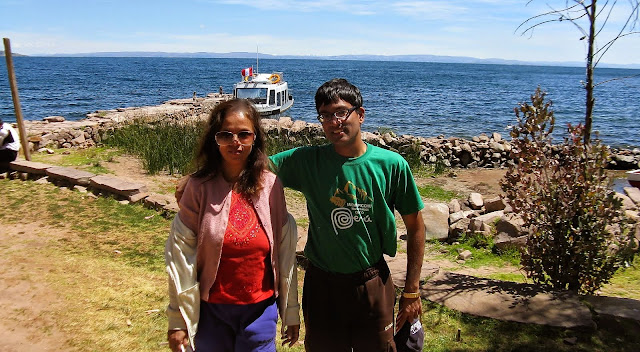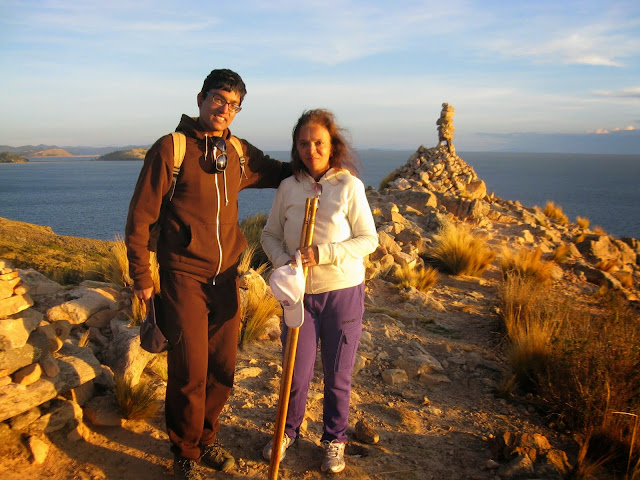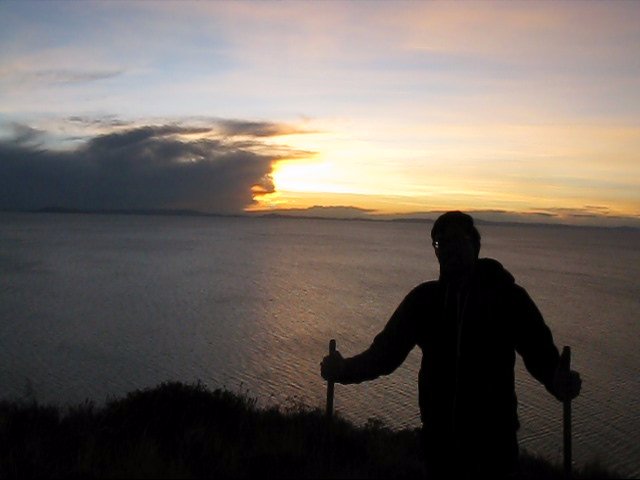DAY 8, Dec 4, 2014:
“Ruta del Sol” (Route of The Sun):
Some people
choose to fly from Cusco to Juliaca to be at Lake Titicaca. We chose
to take the bus ride Cusco-Puno, to enjoy the sights on the way.
Juliaca is 28 miles from Puno and both are on the famed Lake
Titicaca (see the map further down in this post). We were quite happy how our plan turned out! This is the gorgeous lake Titicaca...
This is the map
of the “Ruta del Sol” (Route of The Sun). Yes, the high altitude
of all the places need special scrutiny. We were well acclimatized,
so were able to enjoy the whole ride and all the stops/sight seeing
on the way:
Andahuaylillas Church,Huaro
/ Raqchi Inca Remains, Sicuani Lunch,La Raya Souvenirs,
INC Pukara Museum.
Here we are On
the Inka express starting from Cusco to Puno at 7am. Our hotel had
dropped us at the bus stop at their expense.
Only 17 people in the 40
seater bus.
We took the front seats on both sides...great views. Had a short comfort break here...
Andahuaylillas "Sistine Chapel of America":
Here's the Halt
at Andahuayllialas— 3122 meters altitude.
This is
Andahuaylillas "Sistine Chapel of America"
This is the church of San Pedro Apostol de Andahuaylillas, built by the Jesuits in the 16th century. Like other Spanish and religious constructions of the time, it was built on top of a huaca, or sacred place for the Incas. Made out of adobe and brick, the church is a small structure consisting of one nave, apse and bell tower. But there's a reason why it's known as the Sistine Chapel of America. It has lovely murals...
Set off through the narrow lanes of the town.
This is Echinopsis pachanoi (syn. Trichocereus pachanoi) — known as San Pedro cactus — is a fast-growing columnar cactus native to the Andes Mountains at 2,000–3,000 m.
Raqchi:
10:15 am : Plaza
de Armas & Santa Isabel at Raqchi— 3450 meters altitude.
Located on the ancient Inca Road in a beautiful valley 11,500 feet above sea level, Raqchi remains home to artisenias, farmers and small ranchers.
Santa Isabel at Raqchi:
Archaeological complex, Raqchi:
This is the Archaeological complex of Raqchi
The most important building inside the complex is the "Wiracocha temple" that according to the old chroniclers was built by the Inca Wiracocha in honor to the Superior God of the Andean people: "Apu Kon Titi Wiracocha". The "temple of Wiracocha" is a great construction for that age. it is classified as "Kallanka", that is, a high building completely covered with straw (wood and "ichu"). Externally it is 92 meters long (302 feet) and 25.25 meter wide (83 feet).
Raqchi "Temple of Wiracocha"The Incas built the temple and surrounding quarters and granaries in the 15th century, only to have the Spanish conquistadors knock much of it down around 1540 and later build their own church in its shadow.
Sicuani:
At 11:45 am, we
halted at Sicuani— 3552 meters altitude. The town is a major
intersection, with the road to Puno/Arequipa passing through here. It
is surrounded by some very pretty hills. Lunch was included in our
bus ticket. This is La Pascana restaurant where we had our buffet
lunch.
We did not have high hopes as I had read some reviews
complaining about heavy crowds of many buses landing at the same
time, and the buffet running out. However, we had a great meal. There
was a good vegetarian selection, again quite unexpected. We were the
only customers as it was not peak season. As said, even our bus had
only 17 seats occupied out of 40!
Pasta was good; so were the veggies.
Sicuani Buffet
Lunch; This cream of quinoa soup was bland though. They charged for water; coffee is free, which we don't take.
This potato roast was great.
Dessert: jelly, custard,
bananas in chocolate sauce.
We left a good tip.
Sicuani
restaurant facade...snakes, puma here as well.
Abra La Raya (La Raya Pass):
2:00 pm: At La
Raya Pass — 4335 meters altitude.
Abra La Raya (La Raya Pass) is the watershed between the valley that drains into Lake Titicaca and the valley that leads down to Cusco and to the Sacred Valley.
The altitude is 4338 m (14,232 feet).
Apu is the holy spirit of mountain...
Inca mythology worked within three realms: Hanan Pacha (the upper realm), Kay Pacha (the human realm) and Uku Pacha (the inner world, or underworld). Mountains — rising up from the human world toward Hanan Pacha — offered the Incas a connection with their most powerful gods.
The apu mountain spirits also served as protectors, watching over their surrounding territories and protecting nearby Inca inhabitants as well as their livestock and crops. In times of trouble, the apus were appeased or called upon through offerings.
Small offerings such as chicha (corn beer) and coca leaves were common. In desperate times, the Incas would resort to human sacrifice. Juanita — the “Inca Ice Maiden” discovered atop Mount Ampato in 1995 (now on display in the Museo Santuarios Andinos in Arequipa) — may well have been a sacrifice offered to the Ampato mountain spirit between 1450 and 1480. [ We saw the mummy in Arequipa and it was a soul stirring sight!!]
Pukara:
3:15 pm: Pukara
Museum — 3900 meters altitude.
The Pukara style is identified by impressive monolithic sculptures with a variety of geometric, zoomorphic, and anthropomorphic images plus intricate, multi-colored pottery in a variety of ritual and domestic forms.
Pukara was the first regional population center in the northern Lake Titicaca Basin during the Late Formative Period (500 BC- AD 200), providing valuable insights into the origins of Andean civilization in the highlands. During its peak it covered over a square kilometer and housed thousands of bureaucrats, priests, artisans, farmers, herders, and possibly warriors.
The bus drove on through a drizzle...
We reached our
destination Puno bus stop, bargained with an autorickshaw for a ride to our hotel.
On the way, we stopped at the Supermercado; son ran in to buy a 7
liter water bottle for our stay while I sat with our bags in the
hired vehicle.
Sonesta Posadas, Puno:
Here we are At
Sonesta Posadas on lake shore, Puno. Checking in...
Our room had a
lovely lake view...we shut off the heater and kept our room window
open thru out...
We bought this 7 liter water bottle from Plaza Vea on
our way from the bus stop. The hotel charges heavily for drinking
water!!
Had some food,
watched the sun set over the awesome lake right from our room at
around 10 pm and slept off.
Day 9, Dec 5, 2014: ISLA SUASI, LAKE TITICACA:
At 5 am we
watched the sun rise from hotel room. So worth it to get up early!
Had our
breakfast.
We had booked a night at the island Isla Suasi which is a
private island in Lake Titicaca.
LAGO TITICACA:
Lake Titicaca is
located in the Andes between Bolivia and Peru. It is the largest
freshwater lake in South America (8400sq km), and is also regarded as
the highest navigable lake in the world at 3810m, 12500ft.
Lake Titicaca is
said to be the cradle of Peru’s ancient civilizations, and has been
populated by numerous Andean cultures, including the Purakas, the
Tiwanakus, and the Incas. The presence of these civilizations,
especially the Incas, can be seen on Lake Titicaca by the ruins they
left behind in the island of the sun and the island of the moon, and
also a mysterious underwater temple thought to be between 1,000 and
1,500 years old.
See this map for Puno, Juliaca, Uros, Taquile and Suasi island....
When we knew we
can have an island stay in such a special place, we jumped at the
chance! We booked 3 nights at Lake Titicaca, the 1st and
3rd at the lake shore in Sonesta Posada and the 2nd
night in the island. This all sounds so complicated, but this was how
I could manage logistics. The island being so remote, it as better to
schedule it in the middle so that we were not too harried to take
their transportation.
We left our big
bags at Sonesta as we were coming back there and took only an
overnight bag to the island.
As part of the
room charges, we paid up for the boat ride to and fro. They were
pretty prompt with emails and everything was arranged. It's a 4 hour
ride to the island in the boat, but on the way in they included 2
stops making the journey 6 hours.
We were picked
up at our hotel and taken to Casa Andina hotel a little further down.
They have their own pier and a boat was to take us to their franchise
hotel at Isla Suasi.
Here we are At Casa Andina reception, waiting for our boat ride to Isla Suasi.
The island is owned by a senior lady Martha and
she lives there in her cottage with her dog. The island is solar
powered... no power from 9pm to 6am.
At the time of our visit, the accommodation was managed by
Casa Andina. But the lady chose not to renew their lease and we were
probably the last guests under the old plan. The owner was opting to
run the show on her own later! Awesome personality living alone on a
remote island in the middle of a huge lake (3840sq km area) at 12500 ft altitude.
There is a chance the island gets cut off when the lake is too
turbulent. Mostly happens in heavy rain and we were OK!! Instead of
the 4 hour boat ride from Puno, people can come in 1 hour time from
Juliaca. Anyway we were very happy how our choice played out for a
stay on a exclusive island.
We were so lucky we were the only guests
on that day and had the whole island and their guided hikes, and boat
rides to ourselves.
When we landed, 2 couples were leaving by the
same boat. When we left the next day, we counted 17 people checking
in... not one group but it had so happened that many people had opted
to come in that day. Our guide had a huge laugh over our luck!!
Lovely ride, with us being the only guests on the boat.
In Andean belief, Titicaca is the
birthplace of the sun. The shimmering deep blue Lake Titicaca is an
awesome sight. Even in summer when we visited it's pretty cool
despite sunny weather and blue skies; in night it's pretty cold!!
guess it's the altitude and the lake around.
In this area, crops are still planted
and harvested by hand. Campesinos (peasants) wear sandals
recycled from truck tires, women work in petticoats and bowler hats,
and llamas are tame as pets. It might appear austere, but seems a
simple and satisfying life. Such an old world charm!!
Our 1st
stop was at Uros island.
Uros island:
The Uros are a
pre-Incan people who live on forty-two self-fashioned floating
islands in Lake Titicaca Puno, Peru and Bolivia.
These islets are made of totora reeds, which grow in the lake. The dense roots that the plants develop and interweave form a natural layer called Khili (about one to two meters thick) that support the islands. They are anchored with ropes attached to sticks driven into the bottom of the lake.
The reeds at the bottoms of the islands rot away fairly quickly, so new reeds are added to the top constantly, about every three months; This is especially important in the rainy season when the reeds rot much faster. The islands last about thirty years. They demonstrated the reed weaving technique.
Then it was a
talk about their food.
Mainly fish ispi,
carachi and catfish. Trout was introduced to the lake from Canada in
1940, and kingfish was introduced from Argentina. Uros also hunt
birds such as seagulls, ducks and flamingos, and graze their cattle
on the islets.
Here's a weaving
specimen.
Many of the
subjects refer to religious ideas and symbols and to social status.
motifs such as snakes, birds, marine creatures, and felines,
Images of composite creatures and human/animal combinations are also
represented. They display a variety of weaving techniques known in Peru,
especially plain weave, slit tapestry, and embroidery.
The purpose of
the island settlements was originally defensive, and if a threat
arose they could be moved. This is a watchtower almost entirely
constructed of reeds.
We refused to
enter their homes as we felt awkward to peep into private lives! I
had specifically told the guide we feel uncomfortable and since we
were the only guests they can go easy. Also told him we will not be shopping. I
think he would have communicated these to them so we were not faced
with sales pitches.
They offered a ride on their special boat... we politely declined.
We tipped the guy who did the demo and had a nice
chat with him. Funnily enough, he was asking us personal questions, he
had mistaken me for my son's sister and he told my son as we were
leaving, your mom is very beautiful!! So I guess people watching is
from both sides!! No need to feel awkward visiting their homes!
[When I was researching I felt that this island is now just for gullible tourists. I felt these people must just come in by boat in the morning, put on a show and leave for their regular homes when tourists go away. No way this was their permanent regular home! I mentioned this to our guide and he laughed his head off... there was no denial! It's very scenic and the concept is awesome, it must have existed in the past, so definitely worth a visit, authentic or not]
The boat rode on
and we reached a big island.
Taquile island:
Taquile is an island in Lake Titicaca, on the Peruvian side,
in the Andean altiplano (high plateau) at nearly 13,000 feet (3,815
meters), above sea level.
This community’s
indigenous, Quechua speaking inhabitants are renowned
worldwide for their dramatically colored finely handwoven textiles.
This is a wide
red belt ( chumpi )... the calendar waistband, depicting the
annual cycles connected to ritual and agricultural activities.
The calendar
waistband depicts elements of the oral tradition of the community and
its history. The belt
is Taquile’s best-known item of dress. Female Taquileans weave
belts, which are worn by men, women, and children.
Women and men
usually sew the woven belt to a stiff, warp-wrapped underbelt (tayka
wak’a), which keeps the belt fl at and supports the back. Belts are
usually worn with the dark side of the central band (upper right)
facing outward.
Here's a
demo...preparing shampoo from a local plant called chukjo. (used as
detergent, shampoo and soap).
Lathered up...and clean
See the difference!
Our guide told
us interesting details about the community.
Unmarried men
wore a finely-knit cap ( ch’ullu soltero ) with a colored base and
white top, without ear flaps.... seen in distant background...
Married
men, especially those who had completed community service, wore a red
and navy blue striped knit cap
( pintay ch’ullu ), filled with design motifs along its length
Red denotes
responsibility while white shows that they can be carefree. Once a
couple decide to marry, they have to live together for 1 year before
getting married and the man has to wear the pom pom of his hat on the
opposite side of his head. If it doesn’t work out the couple
part as friends, if they decide to marry, the celebration lasts for 7
days. The whole community attends but they bring everything
that is required for the celebrations.
They manage the
community through community collectivism and on the Inca moral code
ama sua, ama llulla, ama qhilla, (Quechua for “do not steal, do not
lie, do not be lazy”).
Again it was
very pleasant sitting in these lovely surroundings listening to these details of their life!
ISLA SUASI:
We landed at
Isla Suasi by 11/30... we had cut short shopping time at the UROS,
TAQUILE islands, also their entertainment music/dance.
Waiting in the
golf cart for a ride to our hotel, our boat in the background. Albert
picking up a gas cylinder which had come in the boat.
It's great we
are the only visitors on that day. Hotel sign board here.
Golf cart broke
down here... we had a short walk. [The next day when we leaving we
only had to walk back downhill as the golf cart was out of service.
The 17 visitors who were coming in were huffing and puffing up hill,
looking tired!!]
Checking in at
Casa Andina Isla Suasi.
They have 2 free activities... a sunset hike with guide to the top of the hill in the island and morning guided visit to the museum with Martha's collection of local crafts.
Both were good.
Here we are on the sunset guided hikeResident alpacas...
Sun set at Isla Suasi; full moon starting to peek over the hills. The guided hike was great!
PACHAMAMA mound behind... visitors add rocks to seek blessings of Mother Earth.
DAY 10, Dec 6, 2014,
5am: Watched Sun rise at Isla Suasi.
Wild Vicunas on the horizon during sun rise...
Then roamed around enjoying the beauty.
Saw pudu...
We had our breakfast,
then we had the guided visit to the museum.
Albert was our
guide for both activities and we tipped him.
We took the boat
back to Casa Andina pier at Puno at noon. We were given a lunch box
on the boat, but it was ham sandwiches and we returned it as we are
vegetarians.
When we landed and waited for our drop off at Sonesta, a
girl appeared with 2 boxes with vegetarian sandwiches, french fries
and cookie and apologized for giving us non vegetarian snacks on the
ride! Pretty surprised and pleased. The ride had costed usd 90 per
person for the to and fro trip, but it included the island visits and
guide also... so all in all good!
We arrived by 4.30 pm to Sonesta, checked in again, collected our bags. Enjoyed the surroundings
Resident alpacas...
. We
had booked 4M Express bus from Puno to Chivay over email and they
had told us they'll confirm pickup time over phone to our hotel we
told our hotel to tak the message which would come in by 6pm and
inform us. They did so, we were asked to be ready at 6am for hotel
pickup. This was great because normally in peak season pickup is only
from centro. We watched the sunset in lovely surroundings and went to
sleep.
Colca canyon report is here:
http://adventuretrav.blogspot.com/2017/06/peru-trip-report-day-10-puno-chivay.html
Colca canyon report is here:
http://adventuretrav.blogspot.com/2017/06/peru-trip-report-day-10-puno-chivay.html












































































































































































No comments:
Post a Comment